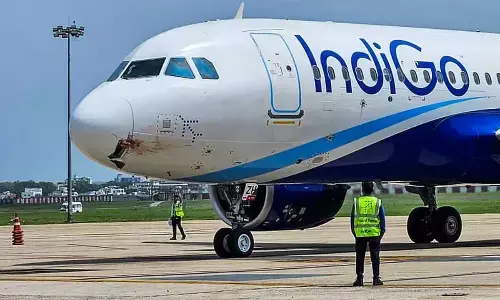Development, water for irrigation reduce migration in Mahbubnagar district
Thanks to various welfare and development initiatives taken up by the State government during the past 6 years, there has been a drastic change that has been witnessed in the lives of people of Palamuru region.
Mahbubnagar: Thanks to various welfare and development initiatives taken up by the State government during the past 6 years, there has been a drastic change that has been witnessed in the lives of people of Palamuru region. The most significant change that has been observed is drastic fall in the incident of migration of people to other States and big cities in search of livelihood.
According to Mahesh Kumar, Assistant Labour Commissioner from Gadwal, with the release of canal water from Jurala, Thumilla and Rajoli Banda Diversion (RDS), the agriculture activity in Gadwal has picked up which is providing lots of employment to the local labourers.
"Earlier more than 50 per cent labourers used to migrate from Gadwal to other States like Karnataka, Maharashtra and Hyderabad for livelihood. However, with the agriculture activities picking up in the district due to abundant availability of irrigation water, the migration has drastically reduced," he observed.
If one looks at the overall picture of Mahbubnagar, earlier out of the total population of 32 lakh, more than 50 per cent people used to migrate to other bigger cities for livelihood. Particularly the people from regions of Narayanpet, Kollapur, Nagarkurnool and Mahbubnagar regions have been migrating to Mumbai, Pune, Hyderabad, Bangalore and a few of them even used to go abroad to Dubai in search of employment.
However, according to latest rough statistics by the Labour department this migration has drastically reduced and only about 5-10 per cent of population have been observed to have migrated to other places. During the past two to three years now, it has come down drastically and people are staying back in their own villages and taking up cultivation and making their own living either by finding self employment or taking up agriculture labour.
According to the Labour department officials, the main reason for reducing migration may because of the release of irrigation water from the completed projects in the district and moreover the Rythu Bandhu and Rythu Bheema schemes of the State government have really reduced the migration.
"Earlier, people used to leave their land barren and go to bigger cities for their livelihood, because they did not have capital investment to take up cultivation, however, with Rythu Bandhu scheme launched by the State government, it has given the farming families to stay back and doing farming at least during rainy season," said an official from the Agriculture department in Mahbubnagar.
In erstwhile Mahbubnagar, the people from Mojerla, Maddigutal from Peddamandadi mandal of Wanaparthy, Kanimetta village from Kottakota, used to go to other cities for work in the rainy season.
However, with canal water and good rains this season, they have stayed back and doing their own cultivation. However, they are sure to go on migrating to other cities for work, but they will leave their houses only in November when there will be no work in their native place.
In Gadwal district, the people in few villages like Gangiman Doddi, Penchkala paadu, Aragidda from Gattu mandal, and people from villages like Lambadi Thandas in Maldakal mandal go to border areas in Karanataka State to take up work as agriculture labourers during the Kharif season. They are expected to leave their villages in the next one or two months soon after completion of their agriculture works in their native places.
However, this time with ample rains, the possibilities of people migrating from these villages is also very less.
A few people from these villages also go to Mumbai, Bangalore and Pune to work as mason and earn good money. They usually come back to their native place once in 6 months during festivals.
The people from villages in Jadcherla, Nagarkurnool and Shadnagar have almost stopped migrating to other places for work, because they are getting livelyhood in their own place. Particularly Jadcherla has become the hot hub for employment, where people from other states are also coming here to work in pharma and other companies located in and around Jadcherla. Similarly is the case with Shadnagar. In Nagarkurnool, the agriculture sector has picked up due to the success of Palamuru Ranga Reddy and Kalwakurthy lift irrigation projects.
It is alleged that earlier, despite of Mahbubnagar district having the Krishna River flowing through it over and about 300 kilometres, the successive governments during the erstwhile Andhra Pradesh had failed to implement any major irrigation or welfare projects that impacted the large masses in the district.
According to Raghava Chari, Palamuru District Forum convener, it is just because of failure of local leaders earlier governments did not focus on this region. "Mahbubnagar is having more than 40 lakh hectares of cultivable land, however, only 12 per cent of this land is under irrigation. With all major pending projects reached their completion and new projects like PRRLI launched in the district irrigation water has been filled into lakes and canals and it is improving agriculture sector in the district.
"Agriculture provides 70 per cent employment in Mahbubnagar, because of lack of planning by earlier governments Mahbubnagar had to remain as a migration district," observed Chari.
Another leader Rajender, member of State BC Welfare Society opined that migration is mainly because of lack of employment opportunities. It is high time that the policy makers and the rulers must come out with concrete policy decisions with committed mindset to bring a change. He added that majority of people who were migrating from the district belong to SC, ST and BC communities.
Many people from Nagarkurnool, Wanaparthy, Gadwal regions have hailed the initiatives of the State government. The most important policy decision taken up by the government is to stem the main cause of migration and it felt providing irrigation water could reverse the migration trend in the once drought-prone Mahbubnagar district which is known for large-scale migration of labourers. Due to some projects being completed and water being released to irrigate the barren lands of the newly formed Jogulamba district, signs of reverse migration are clearly seen across erstwhile Mahbubnagar.
For instance the farmers of Devabanda hamlet under Nettampadu project ayacut area in Gadwal area bordering Karnataka and Rayalaseema who used to migrate to Karnataka are now staying back in their villages and making a livelihood by sowing various crops because of the availability of the canal water.
Earlier of the 200 households in this village, 70 per cent of them use to migrate to Karnataka, Hyderabad and other places because their lands had turned barren due to subsequent drought years.
After the arrival of Krishna River water released since 2016, the villagers are staying back in their villages in Kharif season and making a good living. By lifting Krishna water from Jurala project, irrigation water is being routed from Gudendoddi in Daruru mandal from where the water is filed in Ryalampadu reservoir. From there, through distributaries, water reaches Mucchonipally reservoir in Gattu mandal, Thatikunta reservoir in Maldakal mandal and Nagardoddi mandal in Maldakal mandal.
As of now, through the Nettempadu project, farmers in Daruru, Gattu, Maldakal, Gadwal and Ieeja mandals get irrigation water for tens of thousands of acres. Farmers could be seen busy sowing for the current Yasangi season due to availability of plenty of water this year as well. Water flowing in canals by the side of farm lands is a common sight in Ieeja and Maldakal mandals.
Earlier, the main crops here were just cotton, groundnut and chillies. One would be astonished at the biodiversity thriving in the villages of Leeja and Gattu mandals after their lands are irrigated. Farmers are cultivating paddy, sorghum, sesame, groundnuts, pulses, vegetables, leafy vegetables, groundnuts, chillies, and even tobacco.















